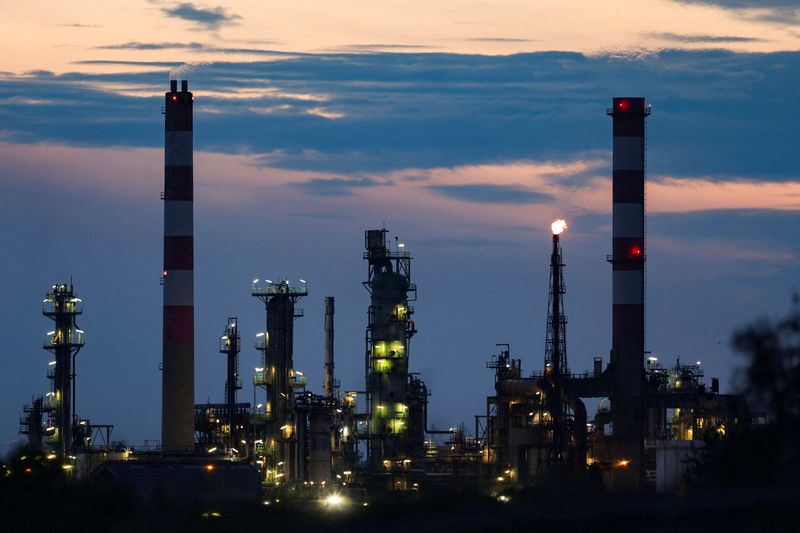Commodities
Oil extends gains with September Fed rate cut in focus

By Deep Kaushik Vakil and Robert Harvey
LONDON (Reuters) -Oil extended gains on Thursday, as support from growing expectations of an interest rate cut from the U.S. Federal Reserve in September outweighed higher U.S. inventories and OPEC+ plans to gradually increase supply.
futures were up 56 cents or 0.7% at $78.97 a barrel by 1150 GMT, while U.S. West Texas Intermediate crude futures were up 63 cents or 0.9% at $74.70.
Oil benchmarks rose more than 1% on Wednesday, recovering after sliding by nearly $8 a barrel to four-month lows over the five sessions through Tuesday.
Nearly two-thirds of economists are now predicting the Fed will cut interest rates in September, according to Reuters’ May 31-June 5 poll, offsetting recent bearish supply news.
Lower interest rates decrease the cost of borrowing, which can incentivise economic activity and boost oil demand.
Prices were still headed for weekly declines of about 3%.
Trading house Trafigura’s chief economist Saad Rahim said that the decision by producer group OPEC+ to phase out some of its output cuts, combined with strong supply in the products market, has driven oil prices lower.
OPEC+, which groups members of the Organization of the Petroleum Exporting Countries (OPEC) and allies, agreed on Sunday to extend most of their production cuts into 2025, but left room for voluntary cuts from eight members to be unwound gradually from October.
“However, demand is holding up and product inventories remain relatively low. As such, if demand accelerates in line with normal seasonal trends it could result in tighter markets going forward,” Rahim said.
OPEC Secretary General Haitham Al Ghais and Russian Deputy Prime Minister Alexander Novak defended the OPEC+ deal, expressing optimism about continued strong demand for oil.
“Oil markets have over-reacted to the mildly negative OPEC+ meeting outcome. Demand indicators have certainly softened somewhat recently, but are not falling off a cliff,” Barclays analyst Amarpreet Singh wrote in a note.
Meanwhile, stocks jumped by 1.2 million barrels in the week to May 31 while analysts had expected a drawdown of 2.3 million barrels, data from the U.S. Energy Information Administration showed.

“Summer inventory draws should be enough to get Brent oil back into the high $80s-$90 range by September,” but prices could come under pressure in 2025 from slower demand and non-OPEC supply growth, J.P.Morgan analysts wrote in a note.
The bank forecasts Brent to average $83 this year and $75 next year.
Commodities
Oil prices rise; U.S. crude inventories plunge, Russia-Ukraine truce eyed
Commodities
India’s Reliance to stop buying Venezuelan oil over US tariffs, sources say
Commodities
Oil prices climb on Venezuela supply worries

 Forex3 years ago
Forex3 years agoForex Today: the dollar is gaining strength amid gloomy sentiment at the start of the Fed’s week

 Forex3 years ago
Forex3 years agoUnbiased review of Pocket Option broker

 Forex3 years ago
Forex3 years agoDollar to pound sterling exchange rate today: Pound plummeted to its lowest since 1985

 Forex3 years ago
Forex3 years agoHow is the Australian dollar doing today?

 Cryptocurrency3 years ago
Cryptocurrency3 years agoWhat happened in the crypto market – current events today

 World3 years ago
World3 years agoWhy are modern video games an art form?

 Commodities3 years ago
Commodities3 years agoCopper continues to fall in price on expectations of lower demand in China

 Economy3 years ago
Economy3 years agoCrude oil tankers double in price due to EU anti-Russian sanctions























